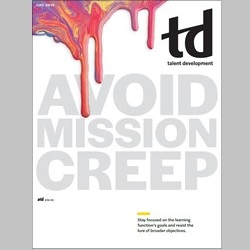TD Magazine Article
It's All About the Impact
Turn measurement data into usable insights to prove the talent development function’s impact on the organization.
Mon Jun 03 2019

Turn measurement data into usable insights to prove the talent development function's impact on the organization.
Today's talent development professionals have a vast array of data available to them, and the importance of telling the story of impact has never been greater. The types of available data continue to evolve and increase over time. There are the traditional sources of data, such as learner performance during and after learning events, participation in talent acceleration activities, and employee engagement data. As data sources have become more readily available, TD professionals are including data on internal movement, employee retention and attrition, promotions, and—equally as important—performance data against business metrics and key performance indicators (KPIs). Data intelligence has become a source for predicting TD solutions' value and impact. Companies leveraging predictive analytics are finding ways to better act upon talent and skills gaps for their organizations.
TD executives are feeling the need and taking the opportunity to use more meaningful measures to make sense of this ever-growing body of data. According to PwC's 15th Annual Global CEO Survey, of the 80 percent of CEOs who say they need talent-related insights to make key decisions, only a small portion receive that information. A new data landscape requires an enlightened TD function—driven by a more rigorous and evolved approach to measurement.
Measurement is no longer just about proving the TD function's worth. Rather, it is about enabling the organization—and especially TD leaders—to maximize the value that the TD function provides.
Workplace transformations drive new thinking about measurement
Two primary industry shifts are affecting measurement today and in the years to come. First, as described above, data analytics is becoming an increasingly critical competency required of TD professionals. HR and TD functions are developing new and powerful tools to measure things they never could before.
I oversee the TD organization at Comcast Cable, a U.S. telecommunications company headquartered in Philadelphia, Pennsylvania. Comcast's enterprise business intelligence team is partnering with the broader HR organization and the TD function to pursue meaningful predictive analytics studies. One of those we have on the timeline is to examine our 90-day onboarding process, which is self-directed and self-paced under an L&D professional's supervision. Through prior measurement, we've found that, in all cases, program results are better when an engaged peer mentor and supervisor pair with a trainer and learner. These new analytics will take the success story a step further by helping to predict retention and sustained performance for newly hired employees who have a dedicated mentor and supervisor.
Today's open learning landscape is a second transformation driving new measurement thinking. At one time, formal learning was the term used to describe anything the training function designed and delivered; everything else was labeled informal. But in today's workplace, learning doesn't have a consistent material form, and the classrooms, devices, and instructors that used to give familiar substance to the process are only a tiny part of that landscape. Employees are finding and leveraging learning content from an abundance of sources.
In a workplace where data are treated as a commodity and learning is taking place everywhere, the TD function must choose—strategically and intentionally—which learning solutions best show its impact. Below are three obligations for TD leaders who want to move beyond proving their value to showing their impact.
Become the trusted source: Connect development to a clear value proposition
The TD value proposition reflects the company's concerns and values and drives the TD function's product and service portfolio. It determines a balance of facilitation, program administration, consultation, use of technology, design, development, and project management. It influences how the function approaches access, technology, customer interface, and cycle time.
Defining the value proposition drives critical decisions about the TD function's business and financial models, structure, and skill sets. The goal here is to be agile—quick to find, assess, select (or help others select), and implement (or enable others to implement) development resources. The end goal is to teach people to be their own trusted source.
Building a coaching culture is part of my TD team's value proposition. We are creating training content that helps frontline leaders and managers have the kinds of conversations that call out positive performance around KPIs. With business partners, we built this initiative, from analysis to implementation.
Measure what matters: Use the organization's metrics as the metrics for assessing impact
Every organization already measures what it thinks is critical, such as sales, cost per unit produced, contributions received, market share, quota attainment, or performance to plan. TD leaders should measure the success of development activities using the same metrics. At the start of each learning program, ask: What measurable business results will be evidence of success and how best should we stage the measurement during design of TD solutions?
The TD function's primary responsibility is to be aligned with the business, for what's happening both in the short and the long term. TD professionals must be linked arm in arm with business partners, whether in the C-suite or the field, understanding what these individuals need. This close alignment during the analysis and design process permits the TD team to state the KPIs that will change the customer experience or business outcomes.
At Comcast, telling business impact stories is part of our DNA. My team holds sessions throughout the year during which individuals volunteer to share the learning programs they implemented and the results, such as increasing an employee's proficiency in a certain skill or growing sales revenue. These ongoing impact stories are part of the company's culture and serve to elevate the TD function's work and link it to business-critical activities. I've never asked my team to prove their value collectively, because our value shows in how we align and deliver to our business partners in every TD interaction.
Be the resource: Measure TD's quality and efficiency
While impact is the most important measure of how TD is helping the organization, quality of service is the most critical indicator of the TD function's success. Every part of every company is obligated to improve over time. For example, employees should produce results more economically than last year, with reduced cycle time, better utilization of resources, and higher customer satisfaction. Done well, the TD function can routinely answer this question: How does the business know it is getting better at developing and delivering meaningful results because of us? With the right metrics, TD leaders can be confident that strategy is working.
The focus of this responsibility is to make sure that, if the organization is discovering new and better ways to get things done, agility is occurring as widely and thoroughly as possible—learning and failing fast is essential to success. It is the TD function's emerging role to help create and support networks that share developmental resources.
Measuring individual impact
In addition to how well the TD function meets organizational expectations, in the future the function must measure its impact on an individual's development. Individual impact expectations will likely fall into several categories:
Help me meet my training requirements.
Help me with training for my current job.
Help me with training for my next job.
Help me with a training plan for my career.
Help me identify training and nontraining options for my current job, next job, or career.
Help me figure out my career goals.
Increasingly, this personal focus will require TD professionals to measure whether each employee has a searchable development profile and report whether everyone has access to multiple virtual and physical learning environments. The TD function will be responsible for real-time measurement and monitoring of the activity stream—who is learning, where it is happening, and who needs help.
Making meaning of metrics
The ability to turn data into usable insights is at the heart of the new capabilities required of a future-looking TD function. To effectively measure where and how development is taking place, leaders will learn how to analyze the organization, discover patterns, and document development.
Conduct an organizational cultural analysis. If working in teams is a fundamental organizational value, learning in teams is critical. If service is basic to the culture, then the tools for learning any number of skills for any number of roles must reflect a commitment to service. If inclusion, a global mindset, or innovation is deeply important to the company, then the approach to learning and the primary resources that support it must reflect those opportunities—and with formats and modalities that meet the employees where they are.
Supporting a mobile workforce is a cultural priority at Comcast. We are now hiring many customer service agents virtually, training them virtually, and leading them virtually. These individuals may never show up in a physical company facility. This practice is important to an evolving workforce. And because many of our interactions take place digitally, we must ensure our employees have similar learning opportunities.
Find the patterns. Patterns are important in data analyses. Understand what the company knows, what it needs to know, and when it needs to know it. Because learning is so fast, widely available, and individualized, the TD function must be the source of reflection on how and when the best learning happens. Search out simple patterns of learning need and deeper patterns reflecting organizational culture and habit.
Document development. To see patterns in the organization, study what's happening. The future requires that the TD function embody the skills of development forensics—the capture, reuse, and modification of organizational learning capability. Such documentation begins by verifying that development has occurred and describing its results. Next, evidence acquisition, collection, and preservation provide proof that people learned from the development and, more importantly, that the perceived result made a meaningful difference in the organization.
What's next?
These new measurement requirements imply a host of competencies, both existing and new, for TD leaders to hone. They must have a better grasp of career development, coaching, job rotation, mentorship, and many other areas in which the TD function currently is less involved.
TD leaders will need greater skills in data analysis and data visualization techniques. The role will require even greater skill in communicating business information to multiple audiences, social networking, and capturing user-generated content. Greater knowledge of statistical theory will be needed, along with the ability to select, design, and evaluate organizational research methods.
As we look at what competencies are needed in the Comcast workforce, we are moving much deeper into the space of people skills, interpersonal interaction skills, and relationship building. In an increasingly digital world, we are finding that social and communication skills are critical.
In the final analysis, all the TD function's activities—its creations and discoveries, both for the organization's and individuals' development—are truly about talent readiness and optimizing the organization's performance. It is TD leaders' responsibility to take this strategic approach to measurement in the future TD function.

